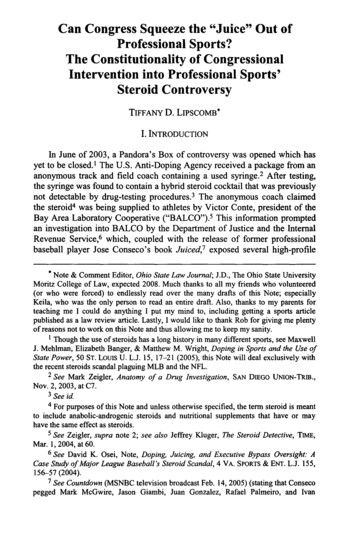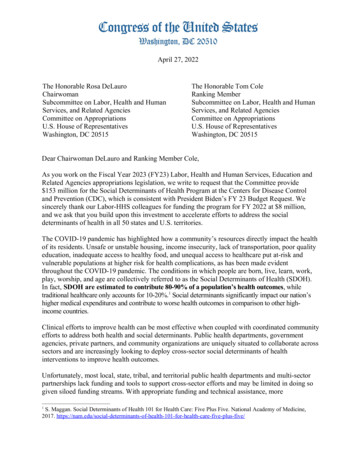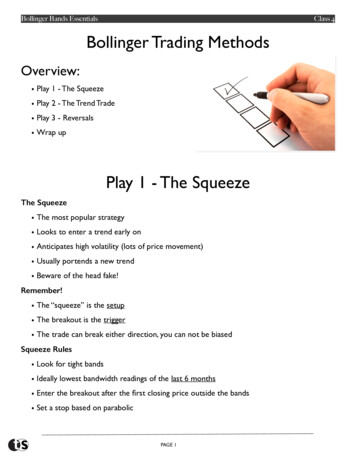
Transcription
Can Congress Squeeze the "Juice" Out ofProfessional Sports?The Constitutionality of CongressionalIntervention into Professional Sports'Steroid ControversyTIFFANY D.LIPSCOMB*I. INTRODUCTIONIn June of 2003, a Pandora's Box of controversy was opened which hasyet to be closed.' The U.S. Anti-Doping Agency received a package from ananonymous track and field coach containing a used syringe. 2 After testing,the syringe was found to contain a hybrid steroid cocktail that was previouslynot detectable by drug-testing procedures. 3 The anonymous coach claimedthe steroid 4 was being supplied to athletes by Victor Conte, president of theBay Area Laboratory Cooperative ("BALCO"). 5 This information promptedan investigation into BALCO by the Department of Justice and the InternalRevenue Service, 6 which, coupled with the release of former professionalbaseball player Jose Conseco's book Juiced,7 exposed several high-profile* Note & Comment Editor, Ohio State Law Journal;J.D., The Ohio State UniversityMoritz College of Law, expected 2008. Much thanks to all my friends who volunteered(or who were forced) to endlessly read over the many drafts of this Note; especiallyKeila, who was the only person to read an entire draft. Also, thanks to my parents forteaching me I could do anything I put my mind to, including getting a sports articlepublished as a law review article. Lastly, I would like to thank Rob for giving me plentyof reasons not to work on this Note and thus allowing me to keep my sanity.I Though the use of steroids has a long history in many different sports, see MaxwellJ. Mehlman, Elizabeth Banger, & Matthew M. Wright, Doping in Sports and the Use ofState Power, 50 ST. Louis U. L.J. 15, 17-21 (2005), this Note will deal exclusively withthe recent steroids scandal plaguing MLB and the NFL.2 See Mark Zeigler, Anatomy of a Drug Investigation, SAN DIEGO UNION-TRiB.,Nov. 2, 2003, at C7.3 See id.4 For purposes of this Note and unless otherwise specified, the term steroid is meantto include anabolic-androgenic steroids and nutritional supplements that have or mayhave the same effect as steroids.5 See Zeigler, supra note 2; see also Jeffrey Kluger, The Steroid Detective, TIME,Mar. 1, 2004, at 60.6 See David K. Osei, Note, Doping, Juicing, and Executive Bypass Oversight: ACase Study of Major League Baseball's Steroid Scandal, 4 VA. SPORTS & ENT. L.J. 155,156-57 (2004).7 See Countdown (MSNBC television broadcast Feb. 14, 2005) (stating that Consecopegged Mark McGwire, Jason Giambi, Juan Gonzalez, Rafael Palmeiro, and Ivan
OHIO STATE LA WJOURNAL[Vol. 69:303athletes to public scrutiny and criminal and congressional questioningregarding possible steroid use.8 Major League Baseball ("MLB") has seenformer heroes such as Jason Giambi, Jeremy Giambi, and Gary Sheffieldhaled before grand juries, 9 while Congress has taken testimony from RafaelPalmeiro, Jose Conseco, and home-run king Mark McGwire.' 0 Potential Hallof Famer Barry Bonds has been in the middle of the controversy as well,serving as a link between many other players and BALCO.II The NationalFootball League ("NFL") also saw players brought before grand juries totestify about steroid use, including four former Oakland Raiders: Bill12Romanowski, Barret Robbins, Chris Copper, and Dana Stubblefield.In 2006, both MLB and the NFL garnered more press coverage, bringingsteroid usage back to the forefront. MLB Hall of Fame ballots baring thename of McGwire prompted a serious debate as to whether or not possiblesteroid use should bar induction of an otherwise likely Hall of Famer.13The NFL saw two steroids stories break, confirming that the problemwith steroids is not only an MLB problem. 14 San Diego Chargers linebackerRodriguez, as well as others, as steroid users); see also Baird Helgeson, CommitteePasses Statewide Testing for Use of Steroids, TAMPA TRIB., Mar. 31, 2005, Metro, at 1(noting that, in Juiced, Conseco claimed to have used steroids and injected MarkMcGwire with steroids).8 See Ian Bishop & Bill Sanderson, Home-Run Hero Bats a Big Zero: McGwireRefuses to Come Clean, N.Y. POST, Mar. 18, 2005, at 6; Helgeson, supra note 7.9 See John Crumpacker & Mark Fainaru-Wada, Sports andDrugs: Star-StuddedDayfor the GrandJury, S.F. CHRON., Dec. 12, 2003, at C1.10 See Bishop & Sanderson, supra note 8.11 See Crumpacker & Fainaru-Wada, supra note 9.12 Id13 See Rick Hummel, Lost in the Shadow, ST. Louis POST-DISPATCH, Jan. 4, 2007, atD1 (observing that there was "more buzz" about McGwire not getting into the Hall ofFame than about Tony Gwynn and Cal Ripken, Jr. being voted in); Michael Hunt, ACertain Hall of Fame Ballot Won't Have McGwire's Name Checked, MILWAUKEE J.SENTINEL, Dec. 3, 2006, at CI (noting that, though McGwire has outstanding statistics,seventy-five percent of Hall of Fame voters have stated they will not vote for McGwire);Tony Massarotti, Covering All Bases; Goin' Out with a Bang, BOSTON HERALD, Dec. 31,2006, at B33 (stating that, due to steroid use, McGwire is "not getting in this time and hemay not get in ever").Though he has not tested positive for steroids, Barry Bonds was reported to havefailed a test for amphetamines, a performance-enhancing drug prohibited by MLB's"Program," explained infra Part II.B. See T.J. Quinn with Bill Madden, FailureLeaves aTesty Bany, Passes Blame to Teammate, DAILY NEWS (N.Y.), Jan. 11, 2007, at 57.Though not the focus of this Note, there are many substances besides steroids that areprohibited by both MLB and the NFL. See infra notes 44, 76 (providing sources forcomplete lists of prohibited substances).14 See generally Phil Taylor, Seeing is Believing: There's Cheating in All ProSports-If You Look Closely, SI.COM, Oct. 25, 2006, http://sportsillustrated.cnn.com/
2008]SPORTS' STEROID CONTROVERSYsensation Shawne Merriman, former Rookie Defensive Player of the Yearand candidate for Defensive Player of the Year in 2006, tested positive inOctober for steroids. 1 5 Perhaps more shocking was the news coverage overthe non-detected steroid use by the 2003 National Football ConferenceChampion Carolina Panthers. James Shortt, a South Carolina doctor, pleadedguilty to conspiracy to distribute steroids and human growth hormone("HGH") to Panthers players. 16 Evidence was produced showing that fiveplayers extensively used steroids during the 2002 season, 17 but the NFL didnot detect the use. 18 This egregious mistake by the NFL may lead to a newround of congressional investigations into doping in professional sports nowthat Democrats have retaken control of the House of Representatives. 19The summer of 2007 saw more steroid stories break. HGH took centerstage, as MLB Commissioner Bud Selig admitted that his sport could notcontrol use of the illegal drug. 20 The NFL suspended player Rodney Harrisonof the New England Patriots, a fourteen-year veteran, for four games after headmitted to using HGH to prosecutors who linked him to a clinic supplyingHGH. 2 1 That same investigation led to a five-game suspension for DallasCowboy quarterbacks coach Wade Wilson when an order he placed with theclinic was discovered. 22 The same investigation has also linked MLB playerRick Ankiel to HGH use. 23 It appears this investigation will uncover more24MLB and NFL player use.The release of the Mitchell Report in December 2007 illustrated just howwidespread steroid use, specifically HGH use, is in major league baseball and2006/writers/phil taylor/10/25/merriman/index.html (noting that steroids are likely as biga problem in the NFL as in the MLB, though the NFL receives less media coverage onthe matter).IS See id.16 See Evan Weiner, Incoming Congress May Tackle Several Sports Issues, N.Y.SUN, Jan. 4,172007, at 18.See Taylor, supra note 14.18 See Weiner, supra note 16.19 See id. (noting that Rep. Henry Waxman, a Democrat from California and newchair of the House Committee on Government Reform, indicated in late summer 2006that he was interested in beginning a new round of congressional hearings).20 See Mike Berardino, Selig's Struggling in his Quest to CorralHGH, S. FLA. SUNJuly 14, 2007, at Sports.21 See Brendan J. Lyons, Steroids Raid Still Reverberating: Six Months AfterFloridaArrests, Probe Snares Pro Athletes, Nets Cash Seizures, TIMES UNION (Albany,SENTINEL,N.Y.), Sept. 17, 2007, at Al.22 Id.23 See T.J. Quinn, Baseball Wants Names; Offers to Help Drug Probe if it Can GetNames Before Media, TIMEs UNION (Albany, N.Y.), Sept. 11, 2007 at B 1.24 See id.
OHIO STATE LA WJOURNAL[Vol. 69:303how detrimental public knowledge of such use is to a player's career. TheReport, commissioned by Commissioner Selig, stated that Andy Pettitte andfuture Hall-of-Famer Roger Clemens both used HGH during their careers. 25Both players are pitchers, 26 demonstrating that steroid use is not limited topower hitters. After the report was released, Pettitte admitted using HGH inboth 2002 and 2004.27 Clemens denied the allegation, leading to aCongressional hearing and a perjury investigation by the FBI. 28 Clemens isquickly becoming "baseball's scarlet letter" 29-his"personal servicescontract" with the Houston Astros 30 and his future hall-of-fame status may be3in danger. 'Both the NFL and MLB have offered to help identify players who haveordered illegal steroids from the Florida clinic, 32 but this willingness toferret-out HGH use may be only a fagade. Though both organizations statedpublicly that they are interested in preventing HGH use, prevention will onlybe possible only with an HGH test.33 Previously, there was no test for HGH;however, a new blood test should be ready to be used by the end of 2007. 34One would think that such a test would be warmly embraced byorganizations that are committed to cleaning up their sports. That does not25 See Bob Hohler, A Long, Star-Studded Drug Roster: Enhancement Use TaintedAll Teams, Sweeping Report Says 'Steroids era'Blamedon a Collective Failure,BOSTONGLOBE, Dec. 14, 2007, at Al.26 See id.27 See Mark Feinsand, Andy Situation is a No-Win, DAILY NEWS (N.Y.), Feb. 29,2008, at 74.28 See id. The evidence of Clemens' steroid use in the Mitchell Report comes fromthe testimony of Clemens' former trainer, Brian McNamee. See Hohler, supra note 25.McNamee claimed to have injected Clemens with HGH himself. See Substance Abuseand Perjury; Dark Cloud over Roger Clemens Reminds That Perjury Is a SeriousCharge,MORNING CALL, Mar. 4, 2008, at A12. After Clemens denied use, Andy Pettitte,a good friend of Clemens, stated in a deposition that Clemens admitted to Pettitte that heused HGH. See Feinsand, supra note 27. Clemens claims that Pettitte "misremembered"the event. Id. Pettitte will likely be "dragged into" the pending FBI investigation inClemens. Id.29 See Christian Red, Suddenly, Rocket Launches Self Home, DAILY NEWS (N.Y.),Mar. 1, 2008, at 46.30 See id. (reporting that, though Astros owner Drayton McLane currently states hewill "honor the [personal services] contract," Clemens' absence from the Astros' minorleague complex suggests that the Astros are "distancing themselves" from Clemens).31 See Hohler, supra note 25 (stressing that Mark McGuire was not admitted to theHall of Fame "amid suspicion of steroid use" and that Clemens may face a similar fate).32 See Quinn supra, note 23.33 See Mike Reiss, HGHIsn't Put to the Test: WADA Official Takes Issue with NFLStance, BOSTON GLOBE, Sept. 9, 2007, at C6.34Id.
2008]SPORTS' STEROID CONTROVERSYappear to be the case. The NFL and the NFL Players' Association havealready stated that they will not use a blood test. 35 Commissioner RogerGoodell hasstated that "players don't feel strongly enough about" HGH tosubmit to blood testing. 36 It appears that the new great steroid threat will notbe willingly combated by professional sports organizations. The use ofsteroids by professional athletes not only raises issues regarding the integrityof sports or the health of athletes, it also has ramifications for the youth ofAmerica. Congressional findings have shown that the use of steroids isescalating in high school as well, with the role-model status of professionalathletes influencing use among America's children. 37 Even President Bush,in his 2004 State of the Union Address, spoke to the effect of professionalathlete use of steroids on children:To help children make right choices, they need good examples. Athleticsplay such an important role in our society, but, unfortunately, some inprofessional sports are not setting much of an example. The use ofperformance-enhancing drugs like steroids in baseball, football, and othersports is dangerous, and it sends the wrong message-that there areshortcuts to accomplishment, and that performance is more important thancharacter. 38The issue has made professional steroid use relevant not only to sportsfans and supporters, but also to those looking out for the well being ofchildren.The possibility of new congressional action 39 on this matter is the centralfocus of this Note. Should Congress be involved in the steroid controversy?If Congress does indeed attempt to help stem the tide of drug use inprofessional sports, what can Congress constitutionally do? Morespecifically, can Congress mandate a drug-testing scheme that would bemore successful than the steroid-testing policies already in place in MLB andthe NFL and, if so, would such a policy violate the Fourth Amendment'sprotection against unreasonable searches and seizures? Part II of this Note35Id.36 Id. As explained in Part III, infra, players have incentives to keep drug testing to aminimum. The lack of satisfactory drug-testing policies in MLB and the NFL can bepartially attributed to player opposition to specific types of testing. See infra Part II.37 See Clean Sports Act of 2005, S. 1114, 109th Cong. § 2 (2005); see also infranotes 269-70 and accompanying text.38 President George W. Bush, State of the Union Address (Jan. 20, 2004), availableat 040120-7.html.39 Congress's ability to intervene in this matter and mandate testing requirementsstems from its power under the Interstate Commerce Clause of the Constitution. SeeMatthew J. Mitten, Drug Testing of Athletes-An Internal,Not External, Matter, 40 NEWENG. L. REv. 797, 805 (2006).
OHIO STATE LA WJOURNAL[Vol. 69:303provides an overview of the current drug-testing policies of MLB and theNFL. Part III explores incentives on both sides of the collective bargainingtable 40 that lead to weak steroid-testing policies Part III also addresseswhether Congress is in a better position to mandate tough policies, andconcludes that Congress should intervene. Part IV tackles the complexquestion of the constitutionality of such congressional intervention byreviewing the jurisprudence of the "special needs" doctrine of the FourthAmendment and applying it to the current steroid issue, using the CleanSports Act of 2005 and the Drug Free Sports Act as examples. Part IVconcludes that congressionally-mandated steroid testing would beunconstitutional. Part V then recommends a possible strategy for Congress toreduce doping in professional sports and among the youth of America,concluding that Congress should focus its efforts on increased testing andeducation of middle and high school students-something that can be doneconstitutionally-while offering tax incentives to professional sportsorganizations and owners in order to incentivize this side of the bargainingtable to fight for tougher policies.II. CURRENT DRUG-TESTING POLICIES OF MLB AND THE NFLA. NFL Steroid Testing PoliciesIn 1987, the NFL was the first professional sports organization to initiatea drug-testing program. 4 1 Actual testing began in 1989, with the currentprogram beginning in 1993.42 This program is regarded as the most extensiveand comprehensive in major American professional sports. 43 The NFLinstituted the program for three reasons: 1) steroids and other substancesthreaten the integrity and fairness of professional football; 2) steroids haveadverse health effects; and 3) the use of steroids by professional athletessends a negative message to the youth of America. 44 No NFL player is40 Both MLB and the NFL are unionized organizations that follow collectivebargaining agreements. See Lisa Pike Masteralexis, Drug Testing Provisions: AnExamination ofDisparitiesin Rules and Collective BargainingAgreement Provisions,40NEW ENG. L. REv. 775, 775-76 (2006).41 See id at 780.42 See Interview with General Counsel Adolpho Birch on the NFL's Drug Policy, 5VAND. J. ENT. L. & PRAc., Winter 2002, at 6.43 See Allan H. "Bud" Selig & Robert D. Manfred, Jr., The Regulation of NutritionalSupplements in ProfessionalSports, 15 STAN. L. & POL'Y REv. 35, 54 (2004) ("The NFLhas the most comprehensive drug-testing policy of the four major sports.").44NAT'L FOOTBALL LEAGUE, POLICY ON ANABOLIC STEROIDS AND RELATEDSUBSTANCES 1-2 (2007) (hereinafter NFL POLICY), available at ances.pdf.
2008]SPORTS' STEROID CONTROVERSYallowed to use any anabolic-androgenic steroid, 4 5 human or animal growthhormone, listed stimulant, or other similar substance. 46 The text belowoutlines the process by which players are tested for such substances.1. Administrationof TestingThe NFL steroid-testing program is directed by the NFL Advisor onAnabolic Steroids and Related Substances ("Advisor") who has "solediscretion to make determinations regarding steroid-related matters,including .testing."4 7 The Advisor also has the duty of making himselfavailable to players and team doctors for consultations and to ensure thateducation on steroid issues is being developed. 48 All testing is done by urineanalysis. 49 The sample is given under observation, and players are notinformed until the day of the test that they will be tested.502. Circumstances That Permit TestingThe NFL has six types of steroid testing: "pre-employment,""annual/preseason," "regular season," "postseason," "off-season," and"reasonable cause testing for players with prior positive tests or under othercircumstances" ("reasonable cause"). 5 1 "Pre-employment" testing may bedone on free agents, both rookies and veterans, and any player who is eligiblefor the NFL draft. 52 "Annual/preseason" testing is done on all players at leastonce a season, during training camp, or when the player reports to his45 An anabolic steroid is defined as: "any of a group of usually synthetic hormonesthat are derivatives of testosterone, are used medically especially to promote tissuegrowth, and are sometimes abused by athletes to increase the size and strength of theirmuscles and improve endurance." MERRIAM-WEBSTER'S ONLINE licsteroid (last visited Apr. 20, 2008).46 Paul A. Fortenberry & Brian E. Hoffman, Illegal Muscle: A ComparativeAnalysisofProposedSteroidLegislation and the Policies in ProfessionalSports' CBAs that Led tothe Steroid Controversy, 5 VA. SPORTS & ENT. L.J. 121, 123 (2006). For a complete listall of all substances banned by the NFL, see NFL POLICY, supra note 44, at 13-16.47 NFL POLICY, supra note 44, at 2.48Id.The Advisor is also required to "participate in research on steroids; confer withthe Consulting Toxicologist; and serve on the League's Advisory Committee on AnabolicSteroids and Related Substances." Id.at 2-3.49Id at3.50 Id at 4 (referring to the collecting of urine samples for analysis).51Id.at 3-4.52 Id.at 3 ("Pre-employment tests may be administered to free agent players(whether rookies or veterans). In addition, the League will conduct tests at its annualtiming and testing sessions for draft-eligible football players.").
OHIO STATE LA WJOURNAL[Vol. 69:303respective team. 53 Random testing of players during the weeks of preseasongames also falls under this type of testing. 54 "Regular season" tests includetesting players from each team randomly selected by the Advisor using acomputer program. 55 There is no cap on the number of times the same playermay be randomly selected for this testing and no guarantee that all playerswill at some point be randomly tested.56 "Postseason" tests are an extensionof the random testing system used in the regular season, but it only applies toteams that are participating in the postseason and only until a team iseliminated from the postseason. 57 Under "off-season" testing, the Advisorcan choose to test up to six times from a pool of all players who are currentlyunder contract. 58 Players are chosen for testing in the same random way testsubjects are chosen for "regular season" testing. 59"Reasonable cause" testing, the most extensive form of testing in theNFL, allows the Advisor to test a player who has a history of steroid use incollege or the pros as often as the Advisor sees fit, both during the seasonand the off-season. 60 It also allows for the testing of players when theAdvisor has information that causes him to reasonably suspect a player ofsteroid use. 6 1 A team may require a player to undergo "reasonable cause"testing if both the team physician and the Advisor agree that the course of62action is appropriate.53 NFL POLICY, supra note 44, at 3.54Id. ("[R]andom testing will be conducted during the weeks in which preseasongames are played.").55 See id.56 See id. at 3-4 (stressing that players can be tested an unlimited amount of times,but not requiring that all players be tested in this manner a minimum number of timesduring a season). Note that players who are subject to the reasonable cause testing are notsubject to random testing of "regular season," "postseason," or "off-season" testing. Id. at4.5758Id. at4.Id.59NFL POLICY, supra note 44, at 4.60 Id. This includes players who have ever tested positive during college, combines,or their pro careers. Id.61 Id62 Id. at 11.
SPORTS' STEROID CONTROVERSY2008]3. Proceduresand Penaltiesfor Positive Test Results63After a player tests positive, 64 the player and the League Office are65notified and a second test, or "B" test, is performed on the remaining urine.If this sample tests positive, the player is said to have a confirmed positivesteroid test.66 All confirmed positive test results are subject to penalties bythe NFL 67 that vary depending on how many times a player has tested68positive.The first positive test leads to a minimum four-game suspension, withoutpay, starting from a date designated by the NFL. 69 A second positive testwarrants a minimum eight-game suspension without pay.70 A third positiveresult lands a player a minimum twelve-month suspension without pay. 71 Inorder to play after a third suspension, a player must petition theCommissioner of the NFL for reinstatement. 72 The Commissioner has thesole discretion to reinstate a player and determine the conditions under whichthat player can return to the NFL. 73 During all suspensions, a player cannotuse team facilities, have contact with team officials, or participate in teamactivities. 74 At the end of any suspension period, a player must test negative63 Included in the NFL plan are procedures and conditions for reinstatement dealingwith medical treatment for players in certain situations. See generally id. at 6-9. Thisaspect of the policy is not covered in this Note.64 Penalties can also be instituted for missing a test date unexcused, attempting tomanipulate a test sample, or diluting or substituting a sample, all of which may meritharsher penalties than a simple positive test result. Id. at 5.65 See NFL POLICY, supra note 44, at 6. A player has a right to waive this "B"sample test. Id.66 See id. at 5-6.67 See id. at 5, 7 (explaining that, even if a player is unaware that an illegalsubstance is in his system, a positive test result will still be punished). Even if a productis approved by a team's trainer or medical staff, a positive result is still punishable. Id. at6. Players with questions must contact the NFL Advisor in order to ensure compliance.See id. at 5.68 See id. at 7-9.69 Id. All suspensions are subject to appeal by the player; such appeals can changethe start date of any suspension. Id. at 10. When there are fewer games remaining in aseason than the suspension mandates, including postseason games the player's team hasqualified for, the suspension will continue into the next season until the entire suspensionperiod has been served. Id. at 7.70 NFL POLICY, supra note 44, at 8.7 Id.72Id.73 Id.74 Id.
OHIO STATE LA WJOURNAL[Vol. 69:303for all substances and pass a physical conducted by the team physician before75returning to the team.B. MLB Steroid Testing PolicyIn early 2005, MLB's Commissioner and the Major League BaseballPlayers Association agreed on a drug-testing policy. This policy, entitled"Major League Baseball's Joint Drug Prevention and Treatment Program"(the "Program"), stated a three-fold purpose: 1) "to educate Players . onthe risks associated with using" steroids; 2) "to deter and end the use byPlayers of' steroids; and 3) "to provide for., an orderly, systematic, andcooperative resolution of any disputes that may arise concerning . theagreement. ' 76 It stated that no Major League player shall use any "anabolicandrogenic steroid[] covered by Schedule III of the Code of FederalRegulations' Schedule of Controlled Substances" or any steroids that are77illegal to obtain.In November of 2005, the "Program" was substantially revamped. 78With the signing of a new collective bargaining agreement in 2006, thisrevamped "Program" was extended through the 2011 season. 79 Below, thespecifics of the original "Program" and the changes that can be found in therevamped "Program" are outlined.1. Administration of Testinga. The Original "Program"The original "Program" was overseen by the Health Policy AdvisoryCommittee (HPAC), composed of two licensed physicians who are experts in75 See id. at 6, 8.76MAJORLEAGUE BASEBALL'SJOINTDRUGPREvENTIoNANDTREATMENTPROGRAM 1 (2005) (hereinafter MLB PROGRAM), available at http://mlb.mlb.comn/mlb/downloads/joint drugprevention and treatment program 2005.pdf. In November2005, amphetamines were added to the list of banned substances. Press Release, MLBPlayers Association, MiLB, MLBPA Announce New Drug Agreement (Nov. 15, 2005),available at eleases.jsp?content 111505#summary. For a complete list of all prohibited substances, see MLB PROGRAM,supra, at 3-4.77 MLB PROGRAM, supra note 76, at 3.78 See Michael Silverman, Baseball; MLB Beefs up its Steroid Policy, BOSTONHERALD, Nov. 16, 2005, at 88 (highlighting aspects of the new MLB Program).79 See Hal Bodley, Deal Brings Labor Peace Through '11, USA TODAY, Oct. 25,2006, at 6C.
SPORTS' STEROID CONTROVERSY2008]drug and steroid use and abuse and two licensed attorneys.80 One of each ischosen by the MLB Players Association, and the others are chosen by theCommissioner. 8 1 HPAC would attempt to make all decisions unanimously,but a majority vote would carry. 82 If a majority vote could not be reached,the physician members would jointly choose another expert, a licensedphysician, to be the fifth member of the committee and cast the decisivevote. 83 HPAC, among other things, was charged with overseeing the testingof players for steroid use following the procedures laid out in the"Program."8 4 All testing was urine analysis8 5 conducted under direct86observation.b. Changes in the Revamped "Program"Under the revamped "Program" much of HPAC's responsibilities havebeen substantially reduced. 87 An Independent Program Administrator, whohas no ties to either MLB or the MLB Players Association, will now oversee:"1. The scheduling of tests"; "2. Supervision of the collection process"; and88"[3.] Reporting of positives."2. Circumstancesthat Permit Testinga. The Original "Program"The "Program" allowed for three different types of testing: "in-season"testing, "additional in-season and off-season" testing, 89 and "reasonablecause" testing. 90 "In-season" testing dictated that each player would berandomly selected for testing once during the season, which began whenplayers reported to spring training and ended with the last regular season80 MLB PROGRAM, supra note 76, at 1.81 Id.82 Id.83 Id. The fifth member would be appointed within forty-eight hours of a failedmajority decision. Id84Id. at 2.85 MLB PROGRAM, supra note 76, at 5.86 Id. at 18. For a complete review of the urine collection and testing procedure, seeid. at 18-28.87 See Press Release, supra note76.88 Id.89 MLB PROGRAM, supra note 76, at 5.90Id. at6.
OHIOSTATE LA WJOURNAL[Vol. 69:303game. 91 "Additional in-season and off-season" testing allowed the Office ofthe Commissioner to do additional random testing of players with the numberand times of these tests to be determined by HPAC. 92 Players could be93randomly selected for this type of testing an unlimited number of times."Reasonable cause" testing happened when any HPAC member hadinformation that caused a reasonable belief that a player had used orotherwise been involved with steroids in the last twelve months. 94 At suchtimes, HPAC would have a meeting, and, if a majority of members agreed,95the player would be tested for steroid use within forty-eight hours.b. Changes in the Revamped "Program"The revamped "Program" increases the frequency of testing of eachplayer, with each player being tested a minimum of twice a year. 96 The firsttest occurs during spring training physicals. 97 The second test happens on arandomly selected date in the regular season and is unannounced. 98 Inaddition to these tests, there will also be year-round random testing ofplayers. 9 9 There is no limit to how many times a player may be subjected tothis random testing. 10 0 It is now the responsibility of the IndependentAdministrator to schedule testing.10 '91 Id. at 5.92 Id.93 See id.("Each Player shall remain subject to such additional tests regardless of thenumber of tests taken by the Player during any calendar year.").94 Id. at 6.95 MLB PROGRAM, supra note 76, at 6.96 See Press Release, supra not
a good friend of Clemens, stated in a deposition that Clemens admitted to Pettitte that he used HGH. See Feinsand, supra note 27. Clemens claims that Pettitte "misremembered" the event. Id. Pettitte will likely be "dragged into" the pending FBI investigation in Clemens. Id.











